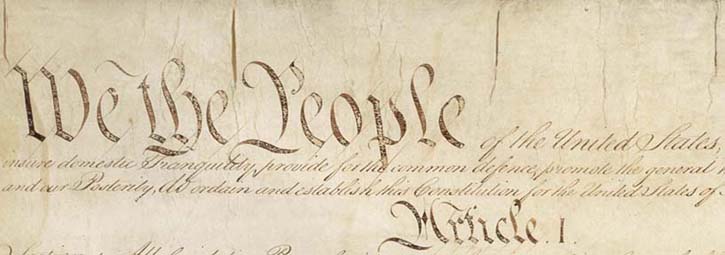
December 24, 2010
U.S Supreme Court Rules to Continue Voter Inequality Nationwide
Washington, DC, December 24, 2010/ -- (Apportionment.US) – The nation’s highest court decided last week to continue denying many Americans the opportunity to achieve equal voting strength relative to the U.S. House of Representatives. Claiming a “lack of jurisdiction” by the federal courts, the U.S. Supreme Court declined to hear arguments in the Clemons v. Department of Commerce case. Plaintiffs had asked the Court to consider whether the House of Representatives’ size of 435 members violates the constitutional principle of “one-person, one-vote” due to the significant inequity it creates.
“With all due respect to the distinguished legal minds that comprise the Supreme Court, their decision to deny review is a tragically missed opportunity that may not come again for a very long time,” said Scott Scharpen, founder and president of Apportionment.US, the non-profit organization that coordinated the lawsuit on behalf of the plaintiffs. “The federal courts clearly have jurisdiction over issues of voter inequity, as evidenced by the long line of ‘one-person, one-vote’ cases from the past 50 years. Because the remedy would require an increase in House membership, however, we believe that the Court does not want to be in the position of forcing the Congress into compliance.” Scharpen adds, “In other words, the alleged respect for a coordinate branch of government appears to trump the fundamental rights of American voters to equality, which is very disappointing indeed.”
While the Constitution gives Congress discretion to set its own size subject to certain requirements, it never intended to give congressmen unfettered discretion due to an obvious conflict of interest: The very House members who do not want to dilute their own power are unlikely to increase their numbers. This is a key reason why the House has not increased its membership in 100 years even though the population of our country has more than tripled. In fact, Congress hasn’t even formally discussed the issue of its own size since 1961.
Even though the federal government over the past 50 years has refined the laws to require the states to achieve precise equality of congressional districts within a small fraction of 1%, the court is disregarding an inequality that now exceeds 460,000 people based on the 2010 census.
Scharpen concludes the matter, “From the filing of the lawsuit in September 2009 up to last week’s ruling, the picture is now complete. Congress has ignored this issue for a half century. Both the Justice Department and the Solicitor General repeatedly stated that equality and proportionality of representation are not required. And the U.S. Supreme Court sidestepped the topic altogether. The result? American voters’ right to equality will continue to be deferred.”
December 13, 2010 -
Apportionment.US announces with great disappointment that the U.S. Supreme Court dismissed our case this morning. Below is the exact order as issued on the Supreme Court website this morning:
APPEAL -- SUMMARY DISPOSITION
10-291 - CLEMONS, JOHN T., ET AL. V. DEPT. OF COMMERCE, ET AL
The judgment of the United States District Court for the Northern District of Mississippi is vacated, and the case is remanded with instructions to dismiss the complaint for lack of jurisdiction.
The “lack of jurisdiction” reference is the Court saying that it doesn’t have the authority to get involved. While we strongly disagree, the Court gets to make the call. More to come...
Video - Introduction to Apportionment.US
This You Tube video is the first in a series of videos that describe Apportionment.US, the lawsuit Clemons v. Department of Commerce, and representation in our federal government. Our You Tube channel is apportionmentus.
Why does America need more representatives and smaller congressional districts?
It will produce smaller government and more individual freedom.
Previous attempts at reforming the United States Congress have aimed at symptoms and not their root cause – enormous district sizes and the related difficulty of faithfully representing the American people with a limited number of representatives.
The advantages of a larger U.S. House of Representatives are:
- INCREASED accountability – as district sizes become smaller, each voter’s influence on their representative increases.
- DECREASED government spending – this seems counter-intuitive, but the data strongly support significant reductions in aggregate spending as the House grows in membership (see the Chen/Malhotra paper from the November 2007 issue of the American Political Science Review).
- INCREASED competition – the principles of free markets tell us that when competition is present, we get increased quality at a lower cost. With more House seats, races will be more competitive. The best illustrative example is comparing small New Hampshire (400 state house members with a high turnover rate of over 30%), to California, with its embarrassing lack of competition (state house of only 80 members with NO turnover - a 100% incumbent success rate for the past 4 election cycles).
- INCREASED voter turnout – data support that the smaller the district sizes, the greater percentage of voters turn out for the election (see the Quidam Voter Turnout paper from October 2009).
- DECREASED cost of running for office – the average winning campaign for a U.S. House seat in 2008 was approximately $1.5 million. This enormous financial barrier to entry prevents ‘average’ citizens from entering national politics, and gives incumbents a great advantage. If the average district size were reduced, more everyday Americans could run for public office.
- DECREASED scope of individual representatives – the problem with the current model is that power is too concentrated, making individual representatives much too influential in the legislative process. Diminishing their individual scope and influence should reduce the need for continual media appearances and campaigning, and re-focus their efforts on serving constituents as citizen-legislators.
- INCREASED freedom – a strong relationship exists between district size and freedom. At the state level, the smaller the average district size, the higher that state scores on various freedom indices (see the Quidam Freedom Indices article from October 2009).
- DECREASED propensity for gerrymandering – With a lot more districts, the concept of creating an oddball-shaped gerrymandered district makes much less sense and yields less value as compared to today’s model.
- INCREASED cost of lobbying – it’s much cheaper and easier to lobby 435 people than a significantly larger number. More representatives may equate to less influence of lobbyists and more protection for the American people.
For a more in-depth analysis on this topic, please read The Root Cause of Ills in the U.S. House by Scott Scharpen.



